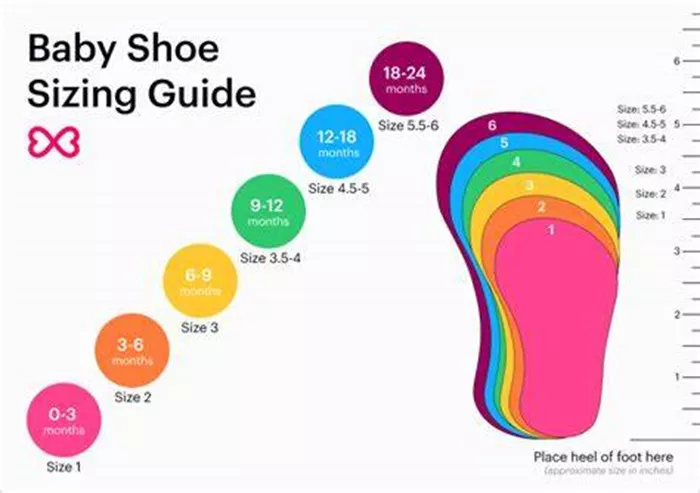Choosing the right shoe size for a one-year-old can be challenging yet crucial for their comfort and development. This guide provides essential insights into understanding baby shoe sizes, how to measure their feet accurately, and tips for selecting the perfect shoes to support their growing feet.
Why Shoe Size Matters for One-Year-Olds
During the first year of life, babies’ feet undergo rapid growth and development. Properly fitting shoes are important as they provide support and protection while allowing natural movement. Ill-fitting shoes can hinder proper foot development and lead to discomfort or potential foot problems in the future.
Factors to Consider When Choosing Baby Shoes
Foot Growth and Development
Babies’ feet grow rapidly in the first few years of life, with significant changes in size and shape. At one year old, their feet are still forming, so it’s crucial to regularly check and update their shoe size as needed to accommodate growth.
Comfort and Fit
The right shoe should fit comfortably without being too tight or too loose. It should provide enough room for the toes to wiggle freely and allow the foot to flex naturally. Look for shoes with soft, flexible materials that conform to the shape of the foot.
Safety and Support
Choose shoes with non-slip soles to prevent slips and falls, especially as your one-year-old begins to explore and walk independently. The shoes should also provide adequate support around the heel and ankle to promote stability.
Breathability and Materials
Opt for shoes made from breathable materials such as leather or mesh to keep your baby’s feet cool and dry. Avoid synthetic materials that can trap moisture and lead to discomfort or skin irritation.
How to Measure Baby Shoe Size
Measure Their Feet Regularly
Babies’ feet can grow quickly, so it’s essential to measure their feet regularly, at least every few months, to ensure they are wearing the correct shoe size.
Use a Foot Measuring Device
You can use a foot measuring device specifically designed for babies or a simple ruler to measure the length of their feet. Ensure they are standing or their foot is flat when measuring for accuracy.
Measure Both Feet
It’s common for one foot to be slightly larger than the other. Always measure both feet and use the larger measurement to determine the correct shoe size.
Consider Growth Room
When choosing shoe size, leave a little room for growth, about a thumb’s width between the longest toe (usually the big toe) and the end of the shoe. This allows room for natural foot movement and growth without being too loose.
Understanding Baby Shoe Size Charts
US, UK, and EU Sizes
Baby shoe sizes are typically labeled in different sizing systems, including US, UK, and EU sizes. Refer to a baby shoe size conversion chart to find the corresponding size in different regions.
Age-Based Sizes
Some baby shoes are labeled according to age ranges, such as 0-6 months, 6-12 months, and so on. However, these age-based sizes can vary between brands, so it’s essential to check the actual measurements (in inches or centimeters) provided by the manufacturer.
Width Fittings
In addition to length, consider the width of your baby’s feet. Some shoe brands offer different width fittings (such as narrow, standard, or wide) to accommodate variations in foot width.
Tips for Choosing Baby Shoes
Flexible and Lightweight
Choose shoes that are lightweight and flexible to support natural foot movements. Soft-soled shoes or shoes with flexible rubber soles are ideal for early walkers as they allow the foot to grip the ground and develop balance.
Easy to Put On
Opt for shoes with adjustable closures such as Velcro straps or elastic laces for easy on and off. This feature also ensures a secure fit without restricting blood circulation.
sEE ALSO:Top 10 Brands For Baby Clothing
Check for Irritants
Inspect the interior of the shoe for any rough seams, tags, or materials that could cause irritation to your baby’s sensitive skin. Choose shoes with smooth, seamless interiors for maximum comfort.
Consider the Season
Select shoes appropriate for the season. In warmer months, choose breathable shoes to keep feet cool. For colder weather, opt for shoes lined with soft materials to keep feet warm and cozy.
Common Questions About Baby Shoes
When Should Babies Start Wearing Shoes?
Babies can start wearing shoes once they begin to walk outdoors regularly or when protection is needed. Before this stage, socks or soft booties provide warmth and some protection indoors.
How Often Should I Replace Baby Shoes?
Monitor your baby’s shoes regularly for signs of wear and tear, especially if they are walking frequently. Replace shoes when they become worn out or when your baby outgrows them.
Can I Buy Shoes Online?
Buying baby shoes online can be convenient, but it’s essential to measure your baby’s feet accurately and refer to the brand’s sizing chart. Check the return policy in case the shoes do not fit as expected.
Conclusion
Choosing the right shoe size for your one-year-old is essential for their comfort, safety, and foot development. By understanding how to measure their feet accurately, considering factors like fit and materials, and selecting shoes that support natural movement, you can ensure your baby walks confidently and comfortably through their early years. Remember, each baby is unique, so observe their reactions to different shoes and adjust as needed to find the perfect fit. With this guide, you’re equipped to make informed decisions when it comes to your baby’s footwear.
Related topics:
Toddler Fall Outfits: A Comprehensive Guide
Choosing The Perfect Toddler Christmas Dress
Discovering Carter’s Dresses: A Shopping Guide

